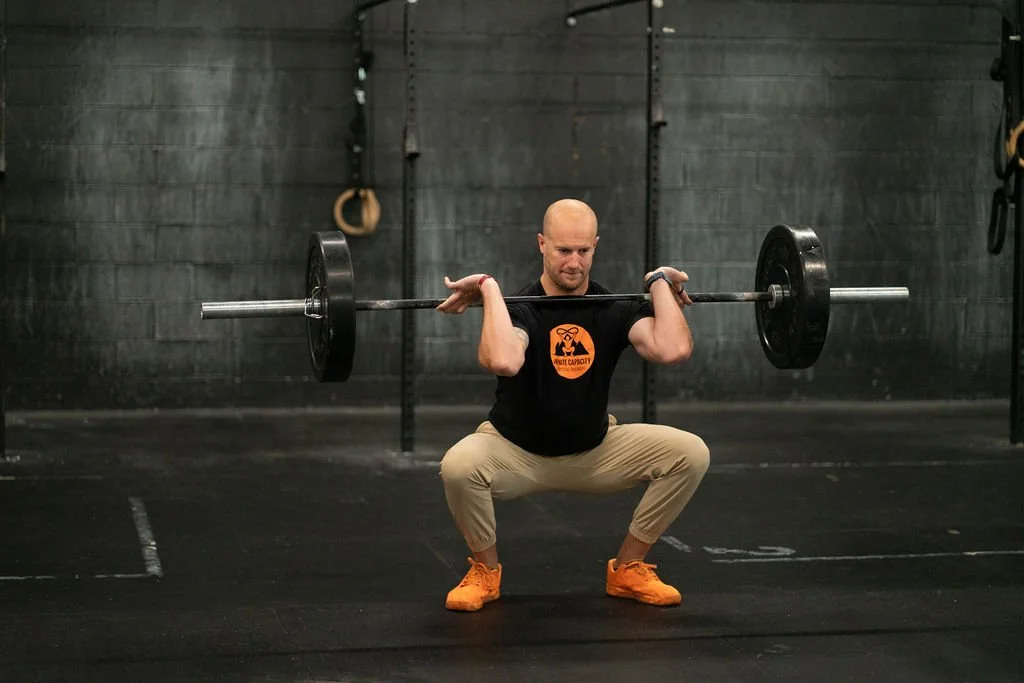How to Fix Knee Pain from Squats (Without Stopping Your Training)
Knee pain during or after squatting is one of the most common issues we see in the clinic. You’re knees aren’t broken, rest isn’t the key, and stopping training isn’t the answer. Most squat-related knee pain is fixable with the proper tools. Here’s how to get back to training pain-free.
Understanding Why Your Knees Hurt When You Squat
The first and most important thing to remember is that pain is a warning sign, NOT an indication that something is broken, torn, or needs imaging. Pain is from inflammation, which is your body’s way of telling you something is off.
Some of the common causes of knee pain we see in athletes and active adults include:
Limited hip mobility
Limited ankle mobility
Weak posterior chain and/or hip stabilizers
Poor movement patterns
Poor load management or training volume spikes
Many of the symptoms experienced in the knee are due to issues in the ankle and/or hip. The knee is sandwiched between the two, so when dysfunction occurs above or below, the knee experiences abnormal stresses to it’s soft tissues resulting in irritation and inflammation.
The Most Common Squat Mistakes That Cause Knee Pain
A key component when evaluating an individual for knee pain with squatting is a comprehensive movement analysis. Identifying common movement faults or training errors can play a significant role in eliminating symptoms and building a treatment plan.
Some of the common faults we readily encounter are:
Initiating the squat with the knees instead of the hips
Knees collapsing inward and not tracking in line with the toes → often hip/glute weakness
Heels lifting off floor → ankle mobility restriction
Excessive forward torso lean (immature squat) → poor bracing or core control
Training errors: too much too soon, too much over a short period, and/or lack of appropriate accessory work
Step-by-Step Process to Fix Knee Pain from Squats
Here at Infinite Capacity, we utilize a 3 Step Process when working with athletes and active adults to resolve knee pain from squatting.
1. Find the Underlying Problem
Don’t just treat the pain—find the root cause of the issue including joint mobility and isolated muscle strength testing.
Movement assessment: video yourself from the front and side to see if you can pick up on any of the movement faults listed above.
Identify whether the issue is mobility, strength, control, loading, or a combination of these factors.
2. Fix the Issue
The first thing we then want to address if it’s part of the problem is mobility:
Ankles: reduce the limitation during squats with heel-elevated goblet squats, and work on improving mobility with dorsiflexion drills like the one in the video below.
Hips: here are two of our favorite hip mobility exercises, one for hip external rotation, and one for hip internal rotation (both equally important in achieving full squat depth).
Once you have started working on mobility limitations, you can then strengthen through those mobility improvements, and work on strengthening underperforming muscles. Isolation exercises can be key to making the strength gains needed to shift those unwanted stresses away from the knees. One group of muscles we typically work a lot in the clinic are the hip external rotators, but your typical clamshells aren’t going to get the job done. Try this exercise in the video below instead.
Learning how to control your body through proper squat mechanics is essential to alleviate symptoms and prevent them from coming back. Incorporating tempo work into your routine can help slow the movement down so you’re able to make those small adjustments needed to ensure proper patterns and positioning.
The final piece is to modify squatting volume and vary the intensity. If you’re only doing high volume high paced body weight squats during metcons, that’s a problem. If you’re only squatting heavy (80+% 1RM) all the time, that’s a problem. Constantly varying the stimulus and periodization are principles to consider in your programming.
3. Perform and Prevent
Once things feel better, it doesn’t stop there! Just because the pain is gone, doesn’t mean the problem has completely resolved and symptoms won’t return.
You need a plan to continue working on the limitations and impairments previously identified. This will lead to the ability to improve your overall performance, and prevent a similar issue in the future.
Ensure you progress appropriately, and in order, through:
Mechanics > Consistency > Intensity
Integrate accessory work such as glute isolation exercises:
Step-ups, lunges, and hip thrusts
Continue mobility and stabilizer activation as needed as part of warm-ups.
When to See a Professional
Many athletes attempt the “Wait and See” approach for far too long. By the time they finally decide to try physical therapy it’s been months or even years! “Wait and See” should only be used for:
Injuries with minimal to no functional loss and < 2 weeks in duration
Injuries or symptoms without significant functional loss that are steadily improving
Otherwise, it’s appropriate to see your local performance physical therapist for:
Injuries resulting in mild to moderate functional loss and/or scaling movements for greater than 2 weeks
Overuse injuries (Achilles tendinitis, plantar fasciitis, shin splints, etc)
Recurrent symptoms (better for a bit, worse again, better for a bit, worse yet again)
General acute or chronic mobility concerns that aren’t improving
Where to find a performance physical therapist who can help you with knee pain from squatting (and one who understands your needs and training demands)
If you’re looking for a physical therapist in South Portland, our clinic, Infinite Capacity Physical Therapy serves the Greater Portland area and we’d love to help you. We help athletes and active adults manage pain so they can continue training and their active lifestyles.
Ready to get rid of knee pain and keep training? Book a discovery call today and start building stronger, pain-free squats.


